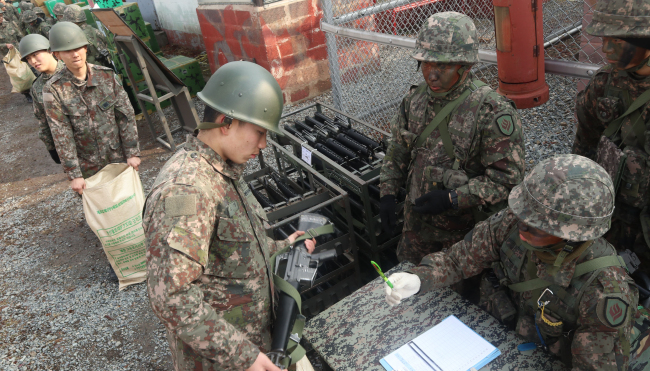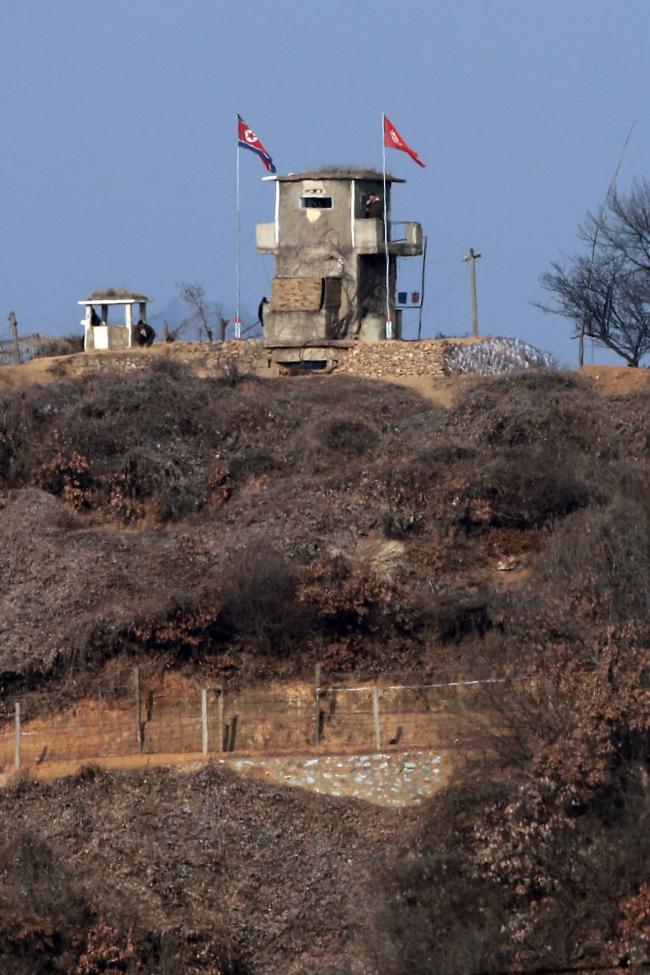The Moon Jae-in administration’s plans to reduce the number of standing troops and period of mandatory service have sparked controversy over whether South Korea can afford to push the initiative amid North Korea’s growing military threat.
In its 2018 policy briefing Friday, the Defense Ministry announced a five-year plan to scale back the mandatory military service period to 18 months from the current 21, along with a separate scheme to reduce the number of armed forces to about 500,000 from 620,000.
The government asserted that the measures were needed to make up for the lack of young conscripts and to modernize the military, but opponents are concerned that they would leave South Korea vulnerable to North Korea’s massive conventional forces.

“The number of troops still matters a lot and nothing has changed in our security landscape,” said Rep. Kim Hack-yong of the main opposition Liberty Korea Party, who serves as chairman of the parliamentary defense committee.
“If the government pushes the agenda to meet the objective and timeline of the president’s election pledge, our military will be reduced to weak forces. … It is nothing but an attempt to reverse our defense policy.”
During his election campaign, Moon advocated cutting the number of troops and mandatory service period, while increasing the salaries of conscripted soldiers. The scheme was then unveiled by his transitional team in July, about two months after Moon took office.
The primary reason for the scaling back of the troop size is based on a projected decrease in the number of young conscripted soldiers mainly due to the country’s low birthrate. Every able-bodied Korean man is mandated to serve for 21 months in the Army, 23 months for the Navy and 24 months for the Air Force.
The military estimates that the number of new draftees -- mostly in their 20s -- would fall from the current 350,000 to 250,000 by 2022, the final year of Moon’s presidency, putting a strain on maintaining the current 620,000-strong armed forces.
“We are seeking to reduce the number of troops and service period to address the shortage of draftees and prevent damage to combat capability,” the president’s transition team said in a report released in July.
However, military analysts warned that the government’s move is too premature, given that South Korea confronts the 1.2 million-strong North Korean Army equipped with large artillery forces capable of sending massive firepower during the initial phase of war.

The experts also cautioned that if the government proceeded with the plan to cut down about 120,000 troops over the next five years, it would lose about 25,000 troops every year -- equivalent to the number of troops in South Korea’s division-level unit positioned along the border area.
Even though military planners here assumed that a new conflict on the Korean Peninsula would not be fought along the similar lines to the Korean War, they argued South Korea still needs a huge number of troops for a stabilization mission in North Korea to prevent counterinsurgency.
In his article titled “The Collapse of North Korea: Military Missions and Requirements,” Bruce Bennett, a senior researcher at RAND Corp., predicted as many as 400,000 troops would be needed to stabilize North Korea in the event of a contingency.
“If a collapse occurs after a war on the peninsula, or if it sparks a civil war in North Korea, the number of missions -- and their requirements -- would grow. Because of the size and complexity of these missions, and because of the perils associated with mismanaging them,” Bennet wrote.
In order to make up for the shortage of conscripted soldiers, the government said it would recruit more officers and noncommissioned officers and assign more conscripted soldiers to the front line by reducing the number of those serving noncombat duties.
The defense ministry also launched a plan to transform the Army-heavy military into modernized joint forces by developing advanced weapons and facilities. Such move will help the military replace the works carried out by rank-and-file soldiers, they said.
But the analysts noted most of the defense budget is allocated much more to purchasing state-of-the-art missile defense system against North Korea than acquiring conventional weapons or recruiting career military personnel.
The government allocated 43.2 trillion won ($38.2 billion) for defense budget in 2018 -- which went up about 7 percent compared to last year. Most of them were earmarked for building so-called a “three-tier” missile shield and improving welfare of conscripted soldiers.
“I don’t think I have seen a case where single-digit increase of defense budget achieved the goals of purchasing advanced weapons and addressing the shortage of soldiers,” said Lee Il-Woo, military analyst at Seoul-based Korea Defense Network.
“The government decided to cut the number of troops first even before they adopt advanced weapon system. That is where we see security vacuum.”
(jasonyeo@heraldcorp.com)








![[KH Explains] How should Korea adjust its trade defenses against Chinese EVs?](http://res.heraldm.com/phpwas/restmb_idxmake.php?idx=644&simg=/content/image/2024/04/15/20240415050562_0.jpg&u=20240415144419)










![[Today’s K-pop] Stray Kids to return soon: report](http://res.heraldm.com/phpwas/restmb_idxmake.php?idx=642&simg=/content/image/2024/04/16/20240416050713_0.jpg&u=)